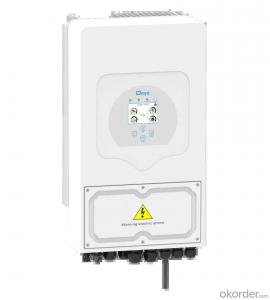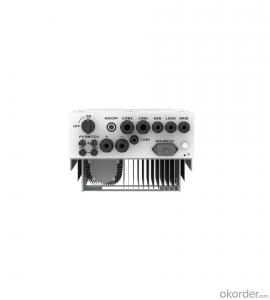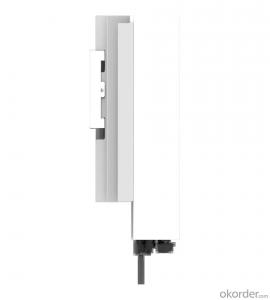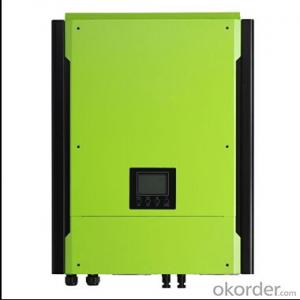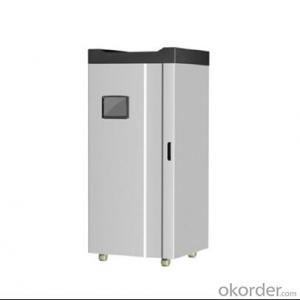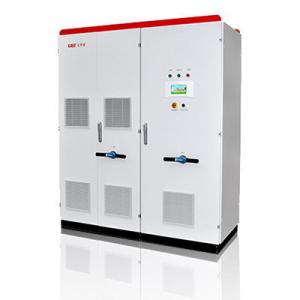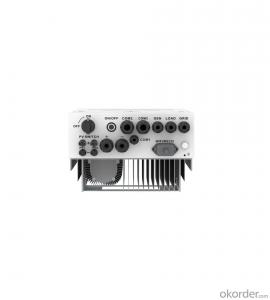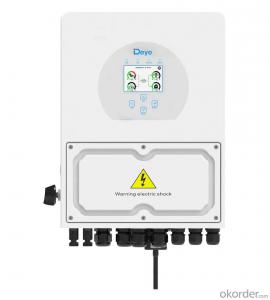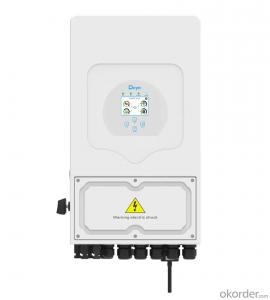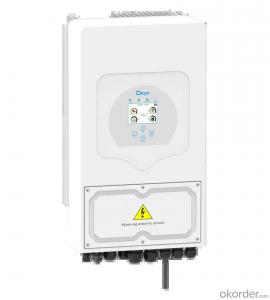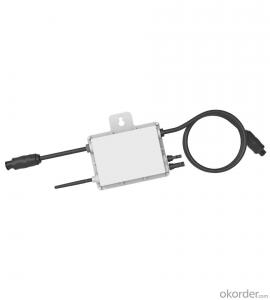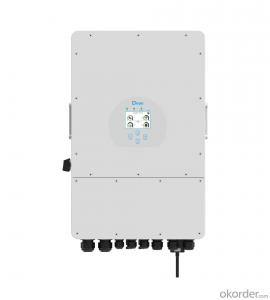Solar Inverter Charger 12v - Sun-3.6-SG03LP1-EU Single Phase 2 MPPT Hybrid Inverter with Low Voltage Battery
- Loading Port:
- Ningbo
- Payment Terms:
- TT OR LC
- Min Order Qty:
- 100 pc
- Supply Capability:
- 5000 pc/month
OKorder Service Pledge
OKorder Financial Service
You Might Also Like
Specification
SUN 6K-SG,hybrid inverter, is suitable for residential and light commercial use, maximizing self-consumption rate of solar energy and increasing your energy impendence. During the day, the PV system generates electricity which will be provided to the loads initially. Then, the excess energy will charge the battery via SUN 6K-SG. Finally, the stored energy can be released when the loads require it. The battery can also be charged by the diesel generator to ensure uninterrupted supply in the event of grid blackout.
100% unbalanced output, each phase; Max. output up to 50% rated power
DC couple and AC couple to retrofit existing solar system
Max. 16pcs parallel for on-grid and off-grid operation; Support multiple batteries parallel
Max. charging/discharging current of 240A
48V low voltage battery, transformer isolation design
6 time periods for battery charging/discharging
| Model | SUN-3.6K -SG03LP1-EU | |
| Battery Input Data | Battery Input Data | |
| Battery Type | Lead-acid or Li-lon | |
| Battery Voltage Range (V) | 40~60 | |
| Max. Charging Current (A) | 90 | |
| Max. Discharging Current (A) | 90 | |
| External Temperature Sensor | Yes | |
| Charging Curve | 3 Stages / Equalization | |
| Charging Strategy for Li-Ion Battery | Self-adaption to BMS | |
| PV String Input Data | ||
| Max. DC Input Power (W) | 4680 | |
| Rated PV Input Voltage (V) | 370 (125~500) | |
| Start-up Voltage (V) | 125 | |
| MPPT Voltage Range (V) | 150-425 | |
| Full Load DC Voltage Range (V) | 300-425 | |
| PV Input Current (A) | 13+13 | |
| Max. PV ISC (A) | 17+17 | |
| Number of MPPT / Strings per MPPT | 2/1+1 | |
| AC Output Data | ||
| Rated AC Output and UPS Power (W) | 3600 | |
| Max. AC Output Power (W) | 3690 | |
| AC Output Rated Current (A) | 16.4 | |
| Max. AC Current (A) | 18 | |
| Max. Continuous AC Passthrough (A) | 35 | |
| Peak Power (off grid) | 2 time of rated power, 10 S | |
| Power Factor | 0.8 leading to 0.8 lagging | |
| Output Frequency and Voltage | 50/60Hz; L/N/PE 220/230Vac (single phase) | |
| Grid Type | Single Phase | |
| DC injection current (mA) | THD<3% (Linear load<1.5%)< td=""> | |
| Efficiency | ||
| Max. Efficiency | 97.60% | |
| Euro Efficiency | 97.00% | |
| MPPT Efficiency | 99.90% | |
| Protection | ||
| Integrated | PV Input Lightning Protection, Anti-islanding Protection, PV String Input Reverse Polarity Protection, Insulation Resistor Detection, Residual Current Monitoring Unit, Output Over Current Protection, Output Shorted Protection, Surge protection | |
| Output Over Voltage Protection | DC Type II/AC Type III | |
| Certifications and Standards | ||
| Grid Regulation | CEI 0-21, VDE-AR-N 4105, NRS 097, IEC 62116, IEC 61727, G99, G98, VDE 0126-1-1, RD 1699, C10-11 | |
| Safety EMC / Standard | IEC/EN 61000-6-1/2/3/4, IEC/EN 62109-1, IEC/EN 62109-2 | |
| General Data | ||
| Operating Temperature Range (℃) | -45~60℃, >45℃ derating | |
| Cooling | Natural cooling | |
| Noise (dB) | <30 dB | |
| Communication with BMS | RS485; CAN | |
| Weight (kg) | 20.5 | |
| Size (mm) | 330W x 580H x232D IP65 | |
| Protection Degree | IP65 | |
| Installation Style | Wall-mounted | |
| Warranty | 5 years | |
- Q: Can a solar inverter be used with different types of electrical appliances?
- Yes, a solar inverter can be used with different types of electrical appliances as long as the appliances are compatible with the inverter's power output. The inverter converts the direct current (DC) generated by the solar panels into alternating current (AC), which can be used to power various electrical devices. However, it is important to ensure that the inverter's capacity and voltage output are suitable for the specific appliances to avoid damage or malfunction.
- Q: What is the function of a solar inverter?
- The function of a solar inverter is to convert the direct current (DC) electricity generated by solar panels into alternating current (AC) electricity that can be used to power household appliances and feed into the electrical grid.
- Q: Can a solar inverter be used in systems with different module efficiencies?
- Yes, a solar inverter can be used in systems with different module efficiencies. Solar inverters are designed to convert the DC power generated by solar modules into AC power that can be used in the electrical grid or for consumption. They are generally compatible with a wide range of module efficiencies and can efficiently handle different power outputs from the solar panels. However, it is important to ensure that the inverter's power rating matches the system's total power output to ensure optimal performance and efficiency.
- Q: What are the safety considerations when installing a solar inverter?
- Some safety considerations when installing a solar inverter include ensuring proper grounding and electrical connections, following manufacturer's guidelines and instructions, and having a licensed electrician perform the installation. It is also important to be cautious of potential electrical hazards and to handle the inverter with care to avoid any personal injuries.
- Q: Can a solar inverter be used in a ground-mounted solar system?
- Yes, a solar inverter can be used in a ground-mounted solar system. In fact, ground-mounted solar systems commonly utilize solar inverters to convert the direct current (DC) generated by the solar panels into alternating current (AC) that can be used to power homes or businesses or fed back into the electrical grid.
- Q: Does a solar inverter require any additional cooling or ventilation?
- Yes, a solar inverter typically requires additional cooling or ventilation. This is because the inverter converts the direct current (DC) generated by solar panels into alternating current (AC) that can be used to power household appliances. During this conversion process, the inverter generates heat, and to maintain optimal performance and prevent overheating, it requires proper cooling or ventilation mechanisms.
- Q: Can a solar inverter be used with a solar-powered agricultural irrigation system?
- Yes, a solar inverter can be used with a solar-powered agricultural irrigation system. A solar inverter is responsible for converting the direct current (DC) electricity generated by solar panels into alternating current (AC) electricity that can be used to power various devices and systems, including irrigation systems. By connecting a solar inverter to the solar panels within an agricultural irrigation system, the generated solar energy can be efficiently utilized to power the irrigation pumps and other components, enabling a sustainable and environmentally-friendly solution for agricultural irrigation.
- Q: Can a solar inverter be used with a wireless communication system?
- Yes, a solar inverter can be used with a wireless communication system. Many modern solar inverters are equipped with built-in wireless communication capabilities, such as Wi-Fi or Bluetooth, to enable monitoring and control of the solar system remotely. This allows users to access real-time data, adjust settings, and receive notifications about their solar energy production and consumption through a wireless connection.
- Q: Can a solar inverter be used with a solar-powered water heating system?
- Yes, a solar inverter can be used with a solar-powered water heating system. The solar inverter converts the direct current (DC) generated by the solar panels into alternating current (AC) that can be used to power the water heating system. This allows for efficient utilization of solar energy and ensures the water heating system operates effectively.
- Q: How does a solar inverter affect the value of a property?
- A solar inverter can positively impact the value of a property by enhancing its energy efficiency and reducing electricity costs. This renewable energy technology is attractive to potential buyers as it provides clean and sustainable power generation. Additionally, having a solar inverter installed can increase the overall appeal and marketability of a property, making it more desirable in today's environmentally conscious market.
Send your message to us
Solar Inverter Charger 12v - Sun-3.6-SG03LP1-EU Single Phase 2 MPPT Hybrid Inverter with Low Voltage Battery
- Loading Port:
- Ningbo
- Payment Terms:
- TT OR LC
- Min Order Qty:
- 100 pc
- Supply Capability:
- 5000 pc/month
OKorder Service Pledge
OKorder Financial Service
Similar products
Hot products
Hot Searches
Related keywords
